 Digital
Digital

 Cenozoic
Cenozoic

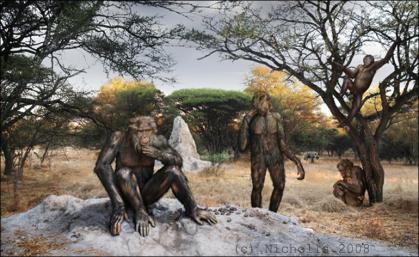
The Termite Mound Troop
Dorling Kindersley Publishing
For a successful life on the Pliocene savannahs, it was essential to see dangers approaching and avoid them. The pelvis and feet of Ardipithecus ramidus allowed it to stand upright and see above the grass, but it would probably not have been a swift runner. However, the expert ability to climb trees was enough to compensate for this.
For a successful life on the Pliocene savannahs, it was essential to see dangers approaching and avoid them. The pelvis and feet of Ardipithecus ramidus allowed it to stand upright and see above the grass, but it would probably not have been a swift runner. However, the expert ability to climb trees was enough to compensate for this.

A Handy Meal
Dorling Kindersley Publishing
Paleontologists are uncertain whether Homo habilis hunted their prey or were scavengers. There is, however, good evidence that this species butchered their food using a variety of stone tools. These included ‘choppers,’ used for breaking bones and cutting through tough tendons, and sharp flakes, which helped remove the skin.
Paleontologists are uncertain whether Homo habilis hunted their prey or were scavengers. There is, however, good evidence that this species butchered their food using a variety of stone tools. These included ‘choppers,’ used for breaking bones and cutting through tough tendons, and sharp flakes, which helped remove the skin.

Ash Land
Dorling Kindersley Publishing
3.6 million years ago, the Sadiman Volcano, 20km east of Laetoli, in Tanzania, was active. It deposited a thin blanket of grey ash across the landscape, which was slowly turned into mud by light rain. Through the mud walked two Australopithecus afarensis, a male and a female, perhaps on their way to greener pastures. Literally in their footsteps, another of their species mysteriously followed.
3.6 million years ago, the Sadiman Volcano, 20km east of Laetoli, in Tanzania, was active. It deposited a thin blanket of grey ash across the landscape, which was slowly turned into mud by light rain. Through the mud walked two Australopithecus afarensis, a male and a female, perhaps on their way to greener pastures. Literally in their footsteps, another of their species mysteriously followed.
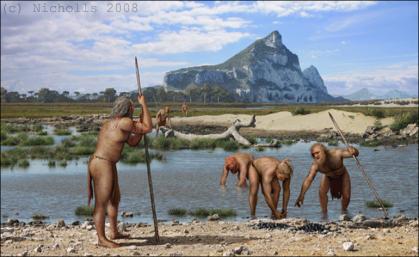
The Neanderthal Rock
Dorling Kindersley Publishing
The Rock of Gibraltar has the most recent Neanderthal occupation sites thus far discovered. Stone tools and hearths, discovered in Ibex, Vanguard, and Gorham’s Caves, suggest Homo neanderthalensis lived there as late as 28,000 years ago. At that time the ocean level was much lower and The Rock was surrounded by coastal plains and lagoons.
The Rock of Gibraltar has the most recent Neanderthal occupation sites thus far discovered. Stone tools and hearths, discovered in Ibex, Vanguard, and Gorham’s Caves, suggest Homo neanderthalensis lived there as late as 28,000 years ago. At that time the ocean level was much lower and The Rock was surrounded by coastal plains and lagoons.
 Mesozoic
Mesozoic


Image of a Dinosaur
London NHM
This digital painting of Tianyulong confuciusi was commissioned by the London Natural History Museum, for the cover of DINOSAURS; HOW THE LIVED AND EVOLVED (second edition). This high profile cover art is an attempt to redefine the image of dinosaurs to a worldwide audience. The roaring monster theropod has gone, here is a feathered ornithischian just eating!
This digital painting of Tianyulong confuciusi was commissioned by the London Natural History Museum, for the cover of DINOSAURS; HOW THE LIVED AND EVOLVED (second edition). This high profile cover art is an attempt to redefine the image of dinosaurs to a worldwide audience. The roaring monster theropod has gone, here is a feathered ornithischian just eating!
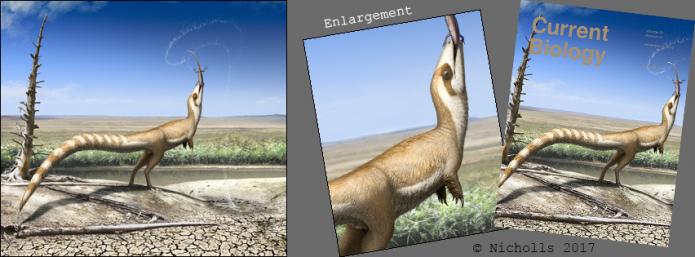
Sinosauropteryx prima
Current Biology/Uni of Bristol
Sinosauropteryx was the first non-bird dinosaur to be discovered with a covering of feathers. Some of the fossils of this theropod are so well reserved that palaeontologists at the University of Bristol were able to observe the melanosomes that coloured the feathers over 122 million years ago, then describe the colour patterns. This painting was featured on the cover of Current Biology for the publication of “Countershading and stripes in the Theropod Dinosaur Sinosauropteryx Reveal Heterogenous Habitats in the Early Cretaceous Jehol Biota,” by Smithwick et al.
Sinosauropteryx was the first non-bird dinosaur to be discovered with a covering of feathers. Some of the fossils of this theropod are so well reserved that palaeontologists at the University of Bristol were able to observe the melanosomes that coloured the feathers over 122 million years ago, then describe the colour patterns. This painting was featured on the cover of Current Biology for the publication of “Countershading and stripes in the Theropod Dinosaur Sinosauropteryx Reveal Heterogenous Habitats in the Early Cretaceous Jehol Biota,” by Smithwick et al.
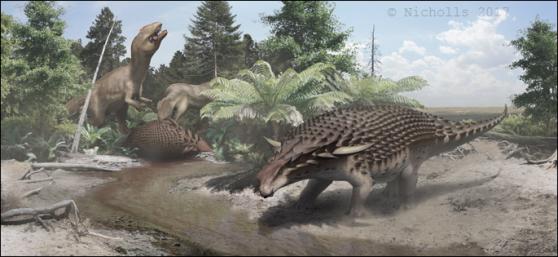
The Constant Threat
Royal Tyrrell Musem
Meet the meat tank Borealopelta markmitchelli. Reconstructed from one of the world's most wonderful fossils, this illustration depicts Borealopelta with accurate colour patterns! The counter colouration suggests that this armoured dinosaur was under constant threat from large predators.
Meet the meat tank Borealopelta markmitchelli. Reconstructed from one of the world's most wonderful fossils, this illustration depicts Borealopelta with accurate colour patterns! The counter colouration suggests that this armoured dinosaur was under constant threat from large predators.

Archosaurian Dawn
Royal Veterinary College, London
On a parched floodplain the desiccated remains of three Aetosauroides have attracted the attention of a flock of Marasuchus. The Marasuchus (Avemetatarsalia) have fuzzy feathers on their backs, whereas the Aetosauroides and the passing Gracilisuchus (Crurotarsi), in the right foreground, have more crocodile-like integument.
On a parched floodplain the desiccated remains of three Aetosauroides have attracted the attention of a flock of Marasuchus. The Marasuchus (Avemetatarsalia) have fuzzy feathers on their backs, whereas the Aetosauroides and the passing Gracilisuchus (Crurotarsi), in the right foreground, have more crocodile-like integument.

In the Spotlight
Nature
In front of a setting sun a Kulindadromeus zabaikalicus looks up quizzically at a falling asymmetrical flight feather (Archaeopterygidae). This scene was commissioned to accompany the publication of "A new hypothesis of dinosaur relationships and early dinosaur evolution," by Matthew Baron et al. It illustrates the new clade Ornithoscelida.
In front of a setting sun a Kulindadromeus zabaikalicus looks up quizzically at a falling asymmetrical flight feather (Archaeopterygidae). This scene was commissioned to accompany the publication of "A new hypothesis of dinosaur relationships and early dinosaur evolution," by Matthew Baron et al. It illustrates the new clade Ornithoscelida.
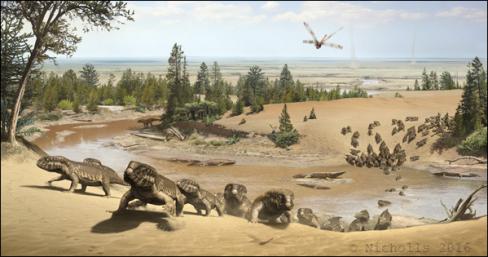
The Langeronyx are on the Move
Heritage & Culture Warwickshire
The Langeronyx bordiei are on the move. The floodplain has become too hot but to reach the shade of the riparian vegetation the herd have to cross a river populated by huge predatory temnospondylls and a rauisuchian approaches along the river bank.
The Langeronyx bordiei are on the move. The floodplain has become too hot but to reach the shade of the riparian vegetation the herd have to cross a river populated by huge predatory temnospondylls and a rauisuchian approaches along the river bank.
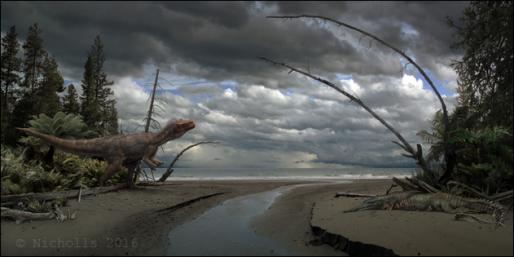
Life & Death on the Beach
Heritage & Culture Warwickshire
A feathered Cruxicheiros newmanorum follows the scent of a rotting Steneosaurus sp. along the beach, while a storm moves in from the sea. This is a scene from Middle Jurassic Yorkshire, England.
A feathered Cruxicheiros newmanorum follows the scent of a rotting Steneosaurus sp. along the beach, while a storm moves in from the sea. This is a scene from Middle Jurassic Yorkshire, England.
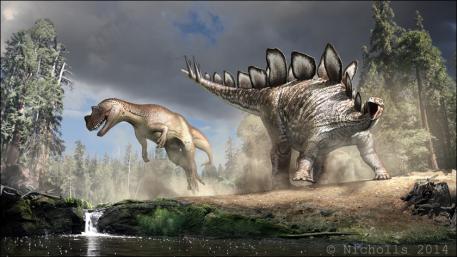
A Lesson Learned
The London Natural History Museum
The London Natural History Museum’s Stegosaurus, named “Sophie,” is the most complete Stegosaurus fossil in the world. In this picture we see Sophie defending herself from a predatory Ceratosaurus, who learns the painful lesson that it is unwise to approach a Stegosaurus from behind. The anatomy of both dinosaurs has been painstakingly reconstructed from the inside out, skeleton to integument, and the illustrated Stegosaurus posture matches the Sophie skeletal mount exhibited in the Natural History Museum’s Earth Gallery.
The London Natural History Museum’s Stegosaurus, named “Sophie,” is the most complete Stegosaurus fossil in the world. In this picture we see Sophie defending herself from a predatory Ceratosaurus, who learns the painful lesson that it is unwise to approach a Stegosaurus from behind. The anatomy of both dinosaurs has been painstakingly reconstructed from the inside out, skeleton to integument, and the illustrated Stegosaurus posture matches the Sophie skeletal mount exhibited in the Natural History Museum’s Earth Gallery.
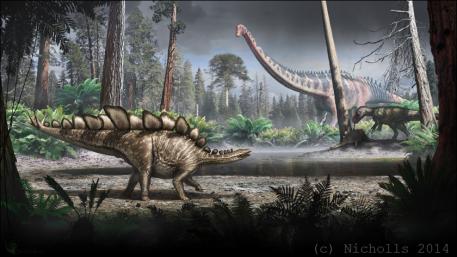
The Great Jurassic
The London Natural History Museum
The London Natural History Museum’s Stegosaurus, named “Sophie,” is the most complete Stegosaurus fossil in the world. In this picture we see Sophie passing through a clearing in a Jurassic riparian landscape. She is surrounded by ferns, seed ferns, cycads, gingko and conifer trees, but also other dinosaurs. The giant sauropod illustrated in the background is Supersaurus and the powerful predator feeding in the shadows is Allosaurus.
The London Natural History Museum’s Stegosaurus, named “Sophie,” is the most complete Stegosaurus fossil in the world. In this picture we see Sophie passing through a clearing in a Jurassic riparian landscape. She is surrounded by ferns, seed ferns, cycads, gingko and conifer trees, but also other dinosaurs. The giant sauropod illustrated in the background is Supersaurus and the powerful predator feeding in the shadows is Allosaurus.
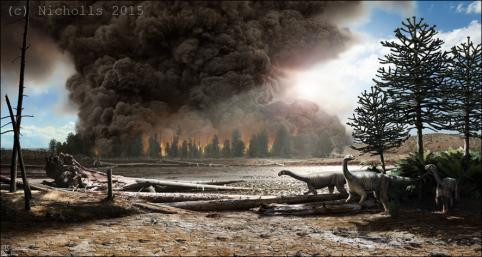
In Search of Water
Naturhistorisches Museum, Bern
Three Plateosaurus -one male (centre) and two females (left and right)- are searching for drinking water beside a shrinking river. Where the river once flowed are drying expanses of mud, littered with deadwood and in the foreground are Eubrontes footprints. This is a dry landscape filled with Dadoxylon and Voltzia trees, ferns, cycads, and Clathropteris, all of which are vunerable to frequent wildfires!
Three Plateosaurus -one male (centre) and two females (left and right)- are searching for drinking water beside a shrinking river. Where the river once flowed are drying expanses of mud, littered with deadwood and in the foreground are Eubrontes footprints. This is a dry landscape filled with Dadoxylon and Voltzia trees, ferns, cycads, and Clathropteris, all of which are vunerable to frequent wildfires!
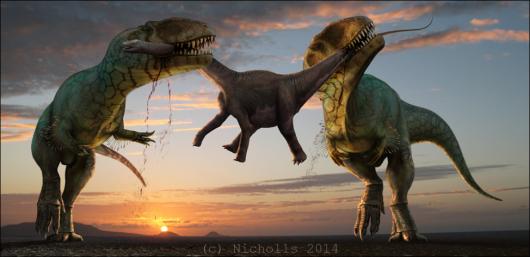
Double Death
Private Commission
Working together these two Carcharodontosaurus saharicusquickly carry away a juvenile Rebbachisaurus garasbae. This new version of Double Death depicts an 8.3 metre long sauropod, with a body mass of 850kg, which is the maximum that two 6t theropods could have carried. This was calculated in Balance and Strength – estimating the maximum prey lifting potential of the large predatory dinosaur Carcharodontosaurus saharicus, by Donald M. Henderson and Robert Nicholls, published in The Anatomical Record.
Working together these two Carcharodontosaurus saharicusquickly carry away a juvenile Rebbachisaurus garasbae. This new version of Double Death depicts an 8.3 metre long sauropod, with a body mass of 850kg, which is the maximum that two 6t theropods could have carried. This was calculated in Balance and Strength – estimating the maximum prey lifting potential of the large predatory dinosaur Carcharodontosaurus saharicus, by Donald M. Henderson and Robert Nicholls, published in The Anatomical Record.
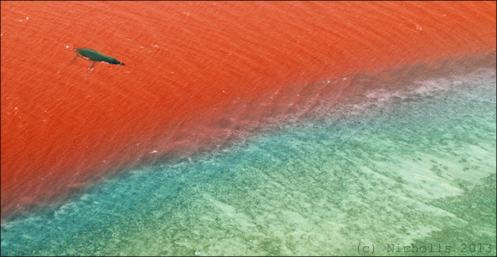
Jurassic Red Tide
Private commission
A paleoartwork with an abstract expressionist twist! Here a Liopeurodon ferox is swimming amongst a bloom of red algae near a coastal coral reef. This was rendered using photographs, digital painting, and an acrylic painted scale model of Liopleurodon.
A paleoartwork with an abstract expressionist twist! Here a Liopeurodon ferox is swimming amongst a bloom of red algae near a coastal coral reef. This was rendered using photographs, digital painting, and an acrylic painted scale model of Liopleurodon.
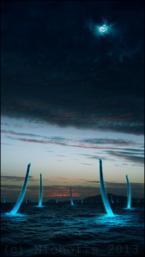
Cretceous Blue Moon
Private commission
By the light of the moon a spectacular annual gathering of Elasmosaurus platyurus takes place. Their courtship requires them to raise their long necks high out of the water to display their strength and suitability for mating (behaviour also speculated by John Conway in All Yesterdays). Remarkably the elasmosaurs chose this particular time and place because it coincides with a seasonal bloom of bioluminescent plankton, which make them glow blue.
By the light of the moon a spectacular annual gathering of Elasmosaurus platyurus takes place. Their courtship requires them to raise their long necks high out of the water to display their strength and suitability for mating (behaviour also speculated by John Conway in All Yesterdays). Remarkably the elasmosaurs chose this particular time and place because it coincides with a seasonal bloom of bioluminescent plankton, which make them glow blue.
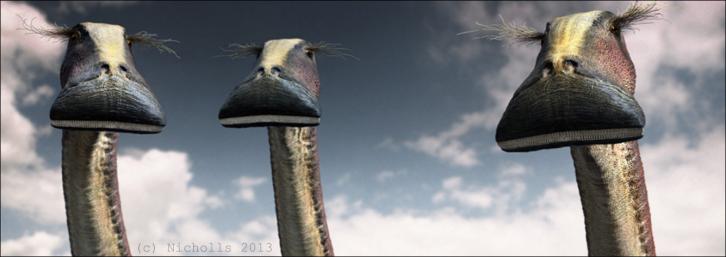
Tom, Dick & Harry
Private commission
Three curious male Nigersaurus taqueti smile at you with toothy grins and show off eyebrows.
Three curious male Nigersaurus taqueti smile at you with toothy grins and show off eyebrows.
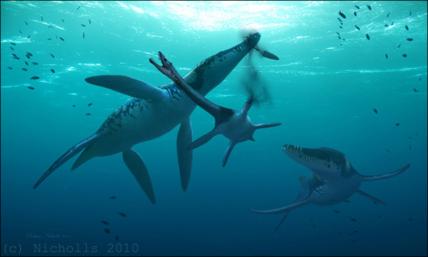
Escaping the Odds
Leicester New Walk Museum
The first Liopleurodon attacked the Muraenosaurus from below and behind. In this ambush the Liopleurodon, a pliosaur, tore away half of a forelimb. But the smell of blood in the water attracts a second nearby Liopleurodon, and the following confrontation will allow the Muraenosaurus, a plesiosaur, to escape!
The first Liopleurodon attacked the Muraenosaurus from below and behind. In this ambush the Liopleurodon, a pliosaur, tore away half of a forelimb. But the smell of blood in the water attracts a second nearby Liopleurodon, and the following confrontation will allow the Muraenosaurus, a plesiosaur, to escape!
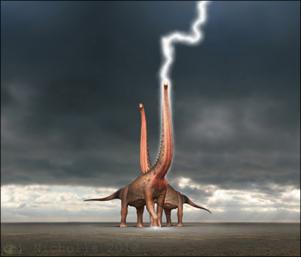
Wrong Place Wrong Time
Private commission
Two rogue Sauropoeidon proteles bulls are crossing a parched floodplain in search of fertile feeding grounds. The two wanderers find themselves dangerously exposed when a thunderstorm looms overhead, then, in a blinding flash, lightening strikes! They were simply in the wrong place at the wrong time.
Two rogue Sauropoeidon proteles bulls are crossing a parched floodplain in search of fertile feeding grounds. The two wanderers find themselves dangerously exposed when a thunderstorm looms overhead, then, in a blinding flash, lightening strikes! They were simply in the wrong place at the wrong time.
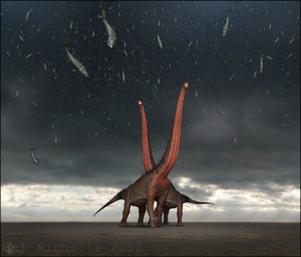
Right Place Right Time
Private commission
This image is the sequel to ‘Wrong Place Wrong Time’ and it is the first palaeoart piece to ever illustrate the meteorological phenomenon of ‘fish rain.’ The fish falling from the sky are Dastilbe and the somphospondylian sauropods are of course Sauroposeidon. You will notice that the nearest Sauroposeidon, the one that was hit by lightening in ‘Wrong Place Wrong Time,’ is just starting to topple over, while his companion is now startled.
This image is the sequel to ‘Wrong Place Wrong Time’ and it is the first palaeoart piece to ever illustrate the meteorological phenomenon of ‘fish rain.’ The fish falling from the sky are Dastilbe and the somphospondylian sauropods are of course Sauroposeidon. You will notice that the nearest Sauroposeidon, the one that was hit by lightening in ‘Wrong Place Wrong Time,’ is just starting to topple over, while his companion is now startled.
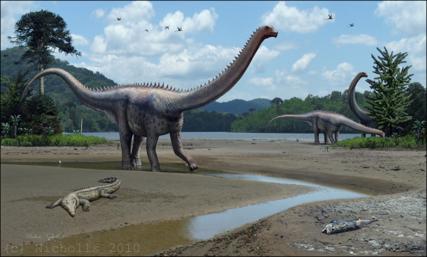
The Rutland Dinosaur
Leicester New Walk Museum
Perhaps the most famous dinosaur skeleton in Britain is the Diplodocus carnegii that stands in the main hall of the Natural History Museum, London. But as wonderful as that dinosaur is, it is a North American species. The British equivalent is the Rutland Dinosaur, a cetiosaurid, and it stands in the Dinosaur Gallery at Leicester New Walk Museum.
Perhaps the most famous dinosaur skeleton in Britain is the Diplodocus carnegii that stands in the main hall of the Natural History Museum, London. But as wonderful as that dinosaur is, it is a North American species. The British equivalent is the Rutland Dinosaur, a cetiosaurid, and it stands in the Dinosaur Gallery at Leicester New Walk Museum.
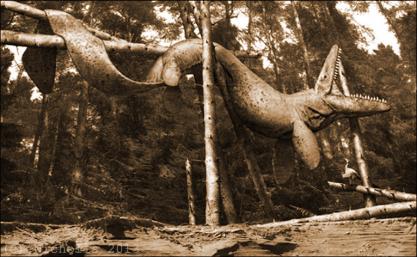
Waterspout Victim (sepia)
Private commission
Strange things happen in nature. Here, a hormone fueled male Mosasaurus has leapt from the waves in an attempt to impress a female and been captured by an unusually powerful waterspout. The waterspout catapulted the mosasaur across a nearby beach into a coastal woodland. Once there, the giant is hung out to dry.
Strange things happen in nature. Here, a hormone fueled male Mosasaurus has leapt from the waves in an attempt to impress a female and been captured by an unusually powerful waterspout. The waterspout catapulted the mosasaur across a nearby beach into a coastal woodland. Once there, the giant is hung out to dry.
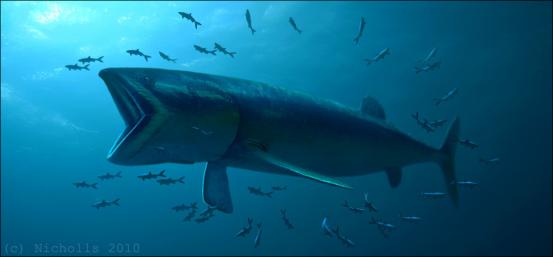
The Big Fish
Peterborough Museum
Leedsichthys problematicus is a gigantic pachycormid fish, about 16m long, known from the Middle Jurassic (the smaller fish are Caturus). This reconstruction was built in collaboration with Dr Mark Evans, New Walk Museum, Leicester, and Dr Jeff Liston, Glasgow. With their assistance, this image is almost certainly the world’s most accurate and up to date reconstruction of Leedsichthys.
Leedsichthys problematicus is a gigantic pachycormid fish, about 16m long, known from the Middle Jurassic (the smaller fish are Caturus). This reconstruction was built in collaboration with Dr Mark Evans, New Walk Museum, Leicester, and Dr Jeff Liston, Glasgow. With their assistance, this image is almost certainly the world’s most accurate and up to date reconstruction of Leedsichthys.

Jurassic Scarborough (Part 1)
Scarborough Rotunda Museum
The view north from Scarborough’s Rotunda Museum would have looked something like this during the Jurassic. Migrating herds of ornithopods are making their way cautiously through a floodplain, while a Megalosaurus bucklandii quietly stalks them. Nearby three alert specimens of the ‘Rutland Dinosaur,’ a Cetiosaurid, watch the predator pass by.
The view north from Scarborough’s Rotunda Museum would have looked something like this during the Jurassic. Migrating herds of ornithopods are making their way cautiously through a floodplain, while a Megalosaurus bucklandii quietly stalks them. Nearby three alert specimens of the ‘Rutland Dinosaur,’ a Cetiosaurid, watch the predator pass by.

Jurassic Scarborough (Part 2)
Scarborough Rotunda Museum
The view southeast from Scarborough’s Rotunda Museum would have looked something like this during the Jurassic. The environment was dominated by ferns, tree ferns, horsetails, cycads, gingko trees and monkey puzzles trees. The four odd-looking trees in the right half of the image are Brachyphyllum, and these are unique to Scarborough. Approaching through the vegetation is a large male Megalosaurus bucklandii.
The view southeast from Scarborough’s Rotunda Museum would have looked something like this during the Jurassic. The environment was dominated by ferns, tree ferns, horsetails, cycads, gingko trees and monkey puzzles trees. The four odd-looking trees in the right half of the image are Brachyphyllum, and these are unique to Scarborough. Approaching through the vegetation is a large male Megalosaurus bucklandii.
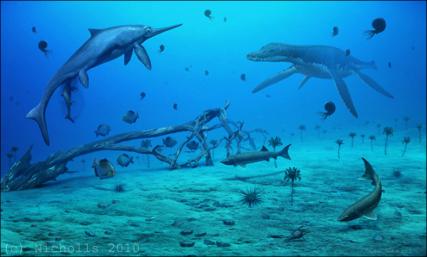
The Lower Lias
Leicester New Walk Museum
A mother Leptonectes gives birth while a hungry Rhomaleosaurus watches menacingly. Around them swim Psiloceras ammonites, Chondrosteus and Dapedium fish, Isocrinus crinoids, Cidaris sea urchins, the crustacean Coleia, the gastropod Pleurotomaria, and a variety of shell fish, including Chlamys and Antiquilima.
A mother Leptonectes gives birth while a hungry Rhomaleosaurus watches menacingly. Around them swim Psiloceras ammonites, Chondrosteus and Dapedium fish, Isocrinus crinoids, Cidaris sea urchins, the crustacean Coleia, the gastropod Pleurotomaria, and a variety of shell fish, including Chlamys and Antiquilima.
 Palaeozoic
Palaeozoic


Diplocaulus Dwelling
Anness Publishing
Diplocaulus marginocolis is known from a large number of fossil specimens. The juveniles possess a salamander-like skull but as the animal grows it develops the characteristic boomerang shaped head. This unique wide head may have been used as a hydrofoil to help keep Diplocaulus on the riverbed in fast flowing water, or it could have made Diplocaulus difficult for predators to eat.
Diplocaulus marginocolis is known from a large number of fossil specimens. The juveniles possess a salamander-like skull but as the animal grows it develops the characteristic boomerang shaped head. This unique wide head may have been used as a hydrofoil to help keep Diplocaulus on the riverbed in fast flowing water, or it could have made Diplocaulus difficult for predators to eat.

